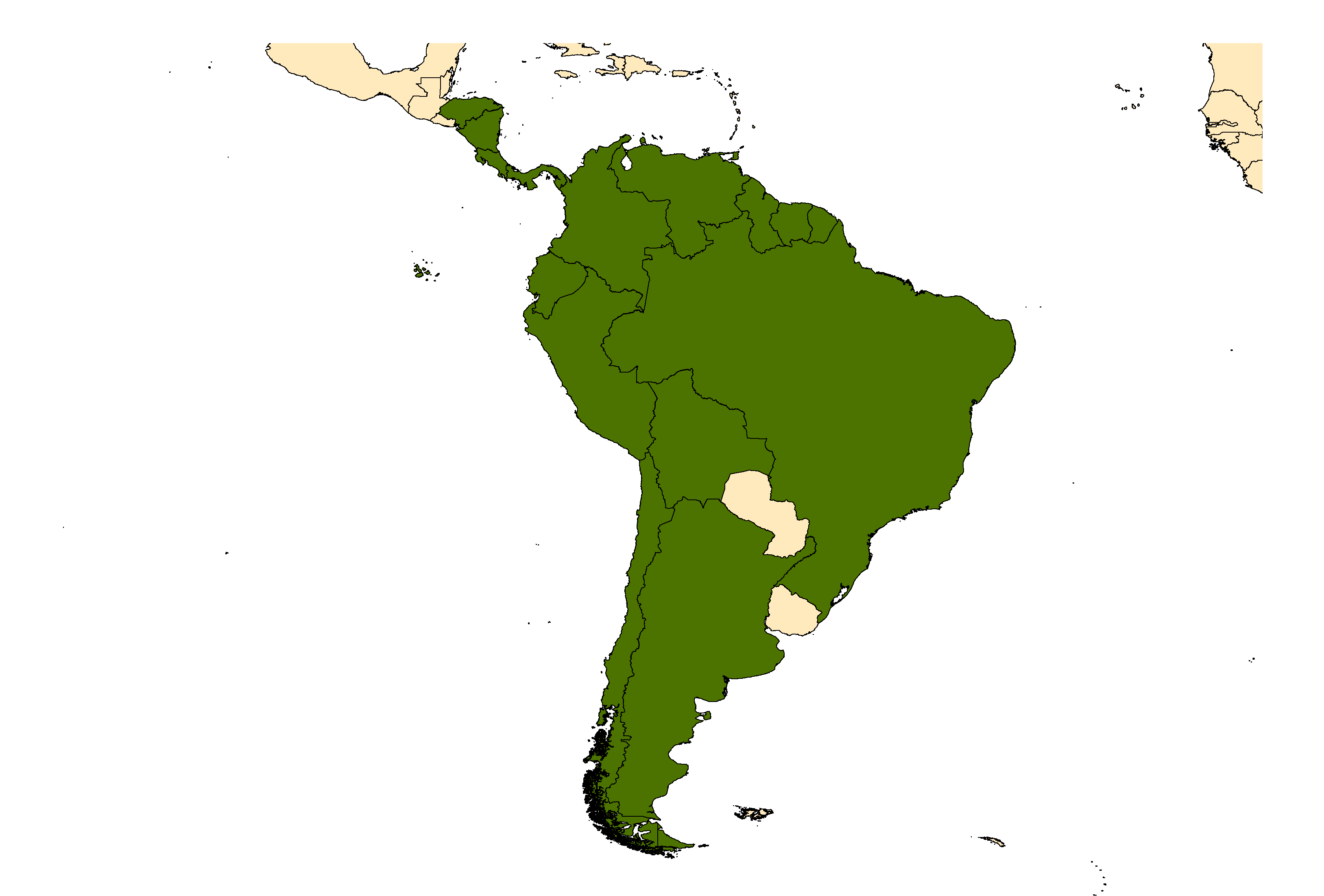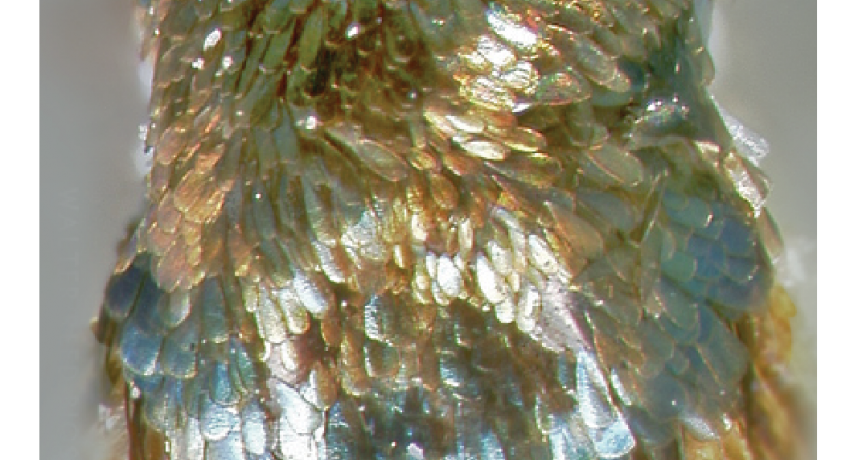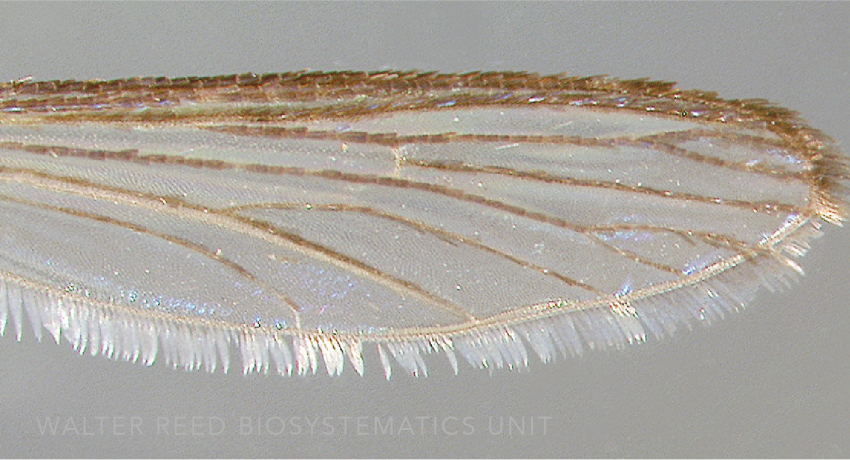NEOTROPICAL REGION
Etymology: not stated [color of violets (Gr); possibly refers to overall purple aspect]
Haemagogus janthinomys is a handsome mosquito, with its thorax clothed in broad silver, golden, and greenish-blue scales, and vivid violet scales on the upper surface of the abdominal segments. Haemagogus janthinomys belongs to the Albomaculatus Section of the subgenus Haemagogus, and is readily distinguishable from all other species in this group—except Hg. capricornii from which it can only be differentiated morphologically using male genitalia characters. That females are essentially isomorphic may have confused accurate bionomic and distributional assignments for these two species.
Type locality: Trinidad [Trinidad & Tobago]
Type depository: U.S. National Museum, Washington, D.C., United States (USNM)
DIAGNOSTIC CHARACTERS (Click photos to view; mouse over and click large photo to zoom in.)
ADULT (illustrated): Thorax: Scutal scales of various metallic colors (green, blue, copper, bronze); scutum with contrasting silver scales in antealar area; pleuron with single broad vertical band of silver scales; lower mesokatepisternum with a well-developed seta; postpronotum densely scaled; mesopostnotum bare; C-I,II with patches of dark scales. Wing: Vein R2+3 usually greater than 0.55 of R2. Legs: Fe-II,III without apical pale spots; Fe-III with silver scales anteriorly extending to apex. Abdomen (dorsal): IV–VIII-Te with dark bluish-green scales on distal margins, contrasting with predominantly purple tergal scales.
LARVA (not illustrated): Head: Seta 6-C single. Abdominal segments: Setae 5–7-P on common tubercle; seta 12-I absent. Terminal segments: Comb scales attached to sclerotized plate, 4–11 CS in a single row, with single pointed, minutely fringed spine; saddle with well-developed spines on caudal margin; boss strongly sclerotized; pecten with spines 10–14, in about basal 0.5 of siphon; seta 1-S 2,3 branched, inserted in about basal 0.55 of siphon.
TAXONOMIC KEYS
Arnell 1973
Becker et al. 2010
![]()
WRBU - Haemagogus - Neotropical Region – Larva
Exemplar DNA sequences
Hg. janthinomys COI: KM593034–35, KY859893–97, MF172319–21, MG242531.
BIONOMICS
Immatures
Immatures of Haemagogus janthinomys are always found in natural container habitats, primarily tree holes. Population densities are greater than five times higher in wet season than in the dry season due to abundance of suitable immature habitat.
Adults
Haemagogus janthinomys is a true arboreal mosquito—found exclusively in primary tropical rain forest throughout most of its range—reaching peak densities at heights over 100m up in the forest canopy. It seldom ventures to ground level to seek bloodmeals, and then, only when the forest is disturbed. In French Guiana, ground host-seeking activity by Hg. janthinomys was shown to be seasonal. The species is multivoltine, with some females laying as many as seven egg batches. It is active during the day (06:00–18:00). Haemagogus janthinomys is extremely plastic in host choice, feeding on primates, birds, rodents, opossums, cattle, horses, dogs, and man, with several individuals noted to take blood from up to three different host species in a single ovicycle. In addition, an average of seven eggs per ovicycle are retained by the females, which may promote trans-ovarial transmission in infected females. Haemagogus janthinomys is an important zoonotic vector for viruses, particularly yellow fever, across its range.
DISTRIBUTION NOTES
Argentina, Bolivia, Brazil, Chile, Colombia, Costa Rica, Ecuador, French Guiana, Guyana, Honduras, Nicaragua, Panama, Peru, Suriname, Trinidad & Tobago, Venezuela.

WRBU VECTOR HAZARD REPORTS
None; View other WRBU Vector Hazard Reports
Available GIS Models:
Hg_janthinomys_Nyari_1 South & Central America
IMPORTANT REFERENCES (full citations below)
Dyar 1921g: 112 (M, F)
Cerqueira 1943a: 10 (synonym)
Bates 1947: 1 (bionomics; as falco)
Lane 1953: 794 (M*; as falco)
Komp 1953 (bionomics, taxonomy)
Komp 1955d (taxonomy)
Stone & Knight 1955: 288 (lectotype designation)
Galindo 1957b: 122 (M*; taxonomy; as falco)
Martínez et al. 1961: 76 (to subspecies)
Arnell 1973: 36 (M*, F*, P*, L*; keys, taxonomy, distribution)
Mattingly 1973a (E*, as Haemagogus spegazzinii)
Alencar et al. 2009 (morphometrics)
Becker et al. 2010: 381 (F*, L*; key, taxonomy, distribution, bionomics)
Liria & Navarro 2010 (niche model)
Linton et al. 2013 (bionomics, molecular taxonomy, distribution; Ecuador)
Berti et al. 2015 (distribution; Venezuela)
CURRENT SYNONYMS
syn. obscurescens Martini
1931a: 212 (F; as uriartei variety). Type locality: Ucayali River, Peru (NHMUK). References: Stone 1957 (1956)a: 339 (synonymy with anastasionis); Arnell 1973: 37 (synonymy).
syn. falco Kumm, Osorno-Mesa & Boshell-Manrique
1946: 14 (M*, F*, L*; as spegazzinii subspecies). Type locality: Volcanes Forest, Caparrapi, Cundinamarca, Colombia (USNM). References: Stone & Knight 1955: 283 (type information); Martínez et al. 1961: 76 (taxonomy); Arnell 1973: 37 (synonymy).
syn. petrocchiae Martínez, Carcavallo & Prosen
1961: 79 (M, F; capricornii ssp.). Type locality: Salvador Mazza (Pocitos), Dept. General San Martin, Salta Province, Argentina (USNM). References: Belkin et al. 1968: 14 (type information); Arnell 1973: 37 (synonymy).
CITED REFERENCES
Alencar, J., Rodriguez-Fernández, J., Dégallier, N., Marcondes, C.B., Costa, J.M., & Guimarães, A.É. (2009). Multivariate discrimination between two cryptic Haemagogus species associated with the transmission of yellow fever virus in the Americas. Journal of the American Mosquito Control Association, 25(1), 18–24.
Arnell, J.H. (1973). Mosquito studies (Diptera, Culicidae). XXXII. A revision of the genus Haemagogus. Contributions of the American Entomological Institute, 10(2), 1–174.
Bates, M. (1947). The development and longevity of Haemagogus mosquitoes under laboratory conditions. Annals of the Entomological Society of America, 40(1), 1–12.
Becker, N., Petrić, D., Zgomba, M., Boase, C., Madon, M., Dahl, C., & Kaiser, A. (2010). Mosquitoes and their control (Second ed.). Berlin Heidelberg: Springer-Verlag.
Belkin, J.N., Schick, R.X., & Heinemann, S.J. (1968). Mosquito studies (Diptera, Culicidae). XI. Mosquitoes originally described from Argentina, Bolivia, Chile, Paraguay, Peru, and Uruguay. Contributions of the American Entomological Institute, 4(1), 9–29.
Berti, J., Guzmán, H., Estrada, Y., & Ramírez, R. (2015). New records of mosquitoes (Diptera: Culicidae) from Bolívar State in South Eastern Venezuela, with 27 new species for the state and 5 of them new in the country. Frontiers in Public Health, 2, 10.
Cerqueira, N.L. (1943a). Algumas espécies novas da Bolívia, e referência a três espécies de Haemagogus (Diptera, Culicidae). Memórias do Instituto Oswaldo Cruz, 39, 1–14.
Dyar, H.G. (1921g). The genus Haemagogus Williston (Diptera, Culicidae). Insecutor Inscitiae Menstruus, 9, 101–114.
Galindo, P. (1957b). On the validity of Haemagogus spegazzinii Falco Kumm et al, 1946 (Diptera, Culicidae). Proceedings of the Entomological Society of Washington, 59, 121–124.
Komp, W.H.W. (1953). Notes on the larva of Haemagogus janthinomys Dyar (Diptera, Culicidae). Proceedings of the Entomological Society of Washington, 57(3), 137–138.
Komp, W.H.W. (1955d). The taxonomic status of Haemagogus janthinomys Dyar (Diptera, Culicidae). Proceedings of the Entomological Society of Washington, 57(6), 277–280.
Kumm, H.W., Osorno-Mesa, E., & Boshell-Manrique, J. (1946). Studies on mosquitoes of the genus Haemagogus in Columbia (Diptera, Culicidae). American Journal of Hygiene, 43, 13–28.
Lane, J. (1953). Neotropical Culicidae (Vols. I, II). São Paulo: University of São Paulo.
Linton, Y.-M., Pecor, J.E., Porter, C.H., Mitchell, L.B., Garzon-Moreno, A., Foley, D H., . . . Wilkerson, R.C. (2013). Mosquitoes of eastern Amazonian Ecuador: biodiversity, bionomics and barcodes. Memórias do Instituto Oswaldo Cruz, 108 (Supplement 1), 100–109.
Liria, J., Navarro, J.-C. (2010). Modelo de nicho ecológico en Haemagogus Williston (Diptera: Culicidae), vectores del virus de la fiebre amarilla. Revista Biomédica, 21(3), 149-161.
Martinez, A., Carcavallo, R.U., & Prosen, A.F. (1961a). El genero Haemagogus Williston, 1896, en la Argentina (Diptera, Culicidae). Anales del Instituto de Medicina Regional Resistencia, 5(2), 63–86.
Martini, E. (1931a). Ueber einige sudamerikanische Culiciden. Revista de Entomología, 1, 199–219.
Mattingly, P.F. (1973a). Mosquito Eggs. XXII. Eggs of two species of Haemagogus Williston. Mosquito Systematics, 5(1), 24–26.
Stone, A. (1957a). Corrections in the taxonomy and nomenclature of mosquitoes (Diptera, Culicidae). Proceedings of the Entomological Society of Washington, 58 (1956), 333–344.
Stone, A., & Knight, K.L. (1955). Type specimens of mosquitos in the United States National Museum: I. The genera Armigeres, Psorophora and Haemagogus (Diptera, Culicidae). Journal of the Washington Academy of Sciences, 45(9), 282–289.
CITE THIS PAGE
Walter Reed Biosystematics Unit (Year). Haemagogus janthinomys species page. Walter Reed Biosystematics Unit Website, http://wrbu.si.edu/vectorspecies/mosquitoes/janthinomys, accessed on [date (e.g. 03 February 2020) when you last viewed the site].











































































































































































